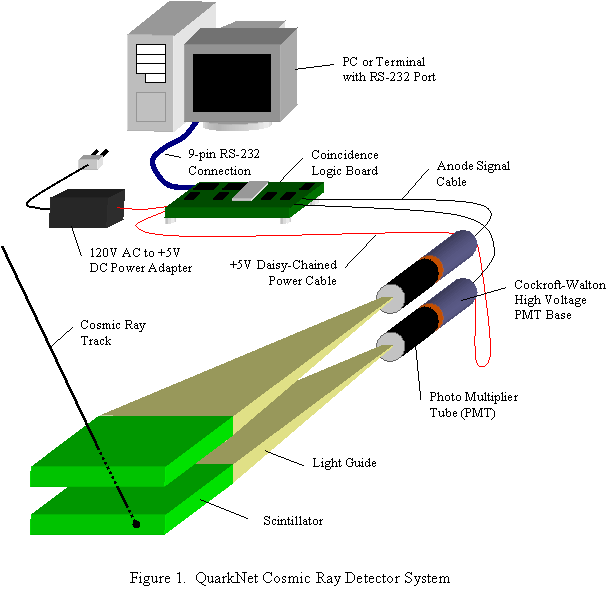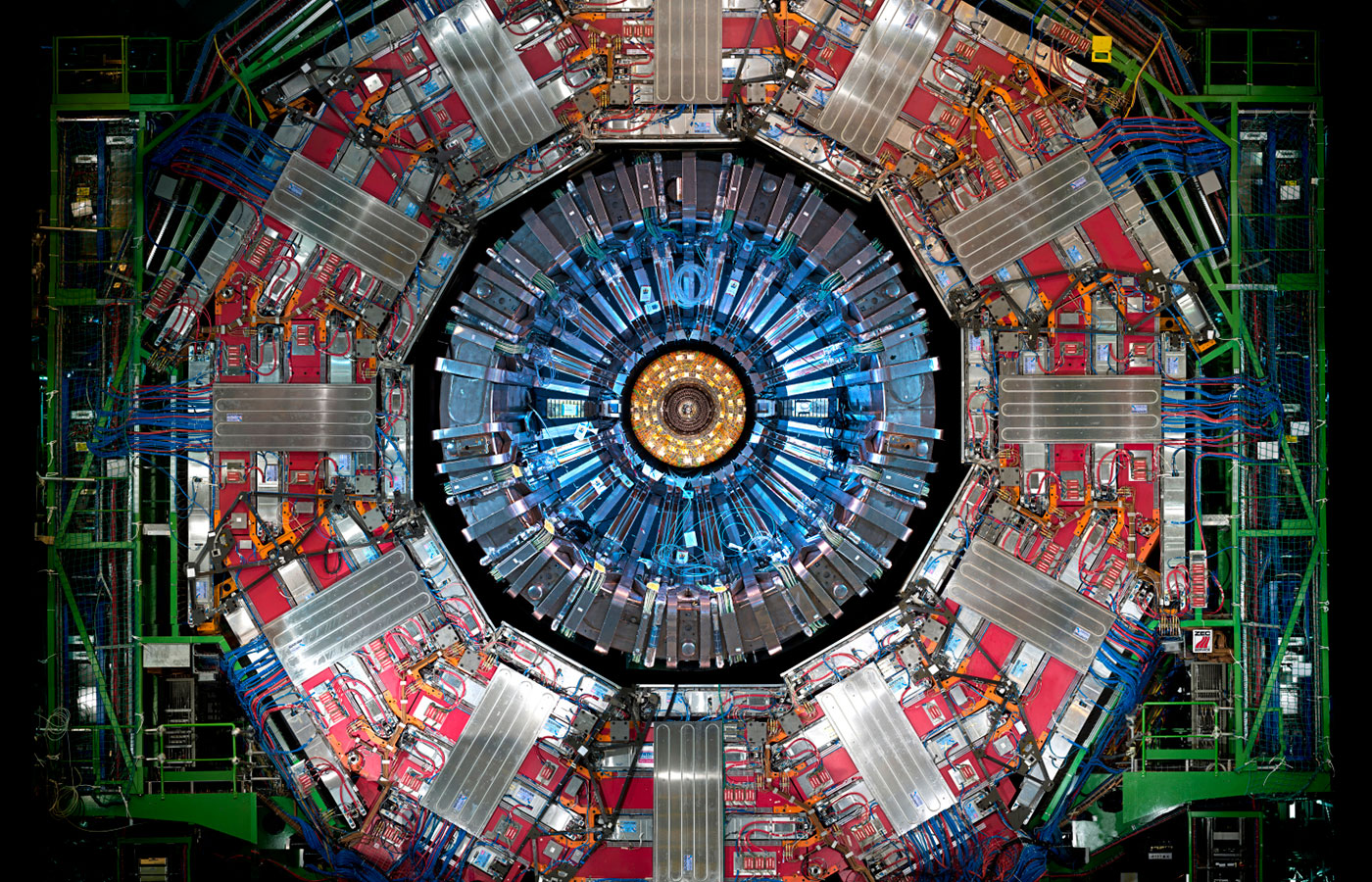QUARKNET
COSMIC RAY DETECTOR SYSTEM
A Paper
Submitted to the Faculty
of
Valparaiso University
by
John Lofgren
In Partial Fulfillment of the
Course Requirements for
Cooperative Engineering Education IV
July, 2001
Faculty Advisor
Prof. Daniel W. Hart
| Title | Page |
|---|---|
| LIST OF FIGURES |
iii |
|
iv |
|
|
v |
|
|
1 |
|
|
2 |
|
| PROJECT GOAL |
4 |
| SYSTEM OVERVIEW |
5 |
|
7 |
|
|
7 |
|
|
8 |
|
|
9 |
|
|
10 |
|
|
10 |
|
|
12 |
|
|
13 |
|
|
Configuration and Data Acquisition |
14 |
| CONCLUSION |
16 |
|
ACKNOWLEDGEMENTS |
17 |
|
BIBLIOGRAPHY |
18 |
|
Figure |
Title |
Page |
|---|---|---|
| 1 | QuarkNet Cosmic Ray Detector System | 5 |
| 2 | Block Diagram of PMT Base | 8 |
| Figure 3 | Block Diagram of Coincidence Logic Board | 11 |
ABSTRACT (Top)
This document details the development of a new version of the Quarknet Cosmic Ray Detector System. The new version includes a revision of the previous coincidence logic board, the addition of a high voltage photo-multiplier tube (PMT) base, and a new AC wall adapter power supply scheme. Efforts were made to streamline the design, to make the system very easy to use, and to keep costs as low as possible. The new design is a significant step toward the goal of a cosmic ray detector that any classroom can afford.
OFFICIAL RELEASE OF ENCLOSED INFORMATION (Top)
Any information contained in this report is authorized to be released to the faculty of Valparaiso University 's College of Engineering and any other persons given permission by the undersigned.
_______________________________________________________
| Sten Hansen Fermilab/PPD/ETT/ES Electrical Engineer |
Date |
INTRODUCTION (Top)
A new version of the QuarkNet Cosmic Ray Detector System has been developed at Fermilab in a continuing effort to create a simple, low-cost cosmic ray detector for use in educational settings. It is intended for use in cosmic ray experiments such as flux monitoring and muon lifetime calculation. The system is specifically being developed to address the needs of a group of high school and college physics teachers known as QuarkNet. This group is associated with Fermilab through the Education Department.
In the past, Fermilab's system only included a coincidence logic board. Fermilab's role has now expanded to also include a self-contained high voltage PMT base and a simple power supply configuration for all the components. To complete the system, it is still left to the teachers to find scintillator, PMTs, and a data acquisition tool (such as a PC).
This paper provides a full description of the system and its development. It is not intended to be a user's guide, although users should find it helpful in understanding the operation of the system. A brief background in cosmic rays is included along with a full description of the system as whole. Sections are also dedicated in more detail to the theory of operation of both the high voltage PMT base and the coincidence logic board.
BACKGROUND IN COSMIC RAYS AND THEIR DETECTION
Cosmic rays are classified under two types, primary and secondary. Primary cosmic rays are particles originating from astrophysical sources (1) . These are various types of particles such as electrons, protons, helium, carbon, oxygen, and iron. They can be emitted by such events as solar flares or exploding supernovae. When primary cosmic rays enter Earth's atmosphere, they produce secondary cosmic rays from collisions with particles in the atmosphere. Secondary cosmic ray particles include lithium, beryllium, and boron nuclei. In addition, these collisions will result in the production of charged and uncharged mesons. The charged mesons decay into muons and neutrinos while the uncharged mesons decay into electrons and neutrinos. Many of the incident primary cosmic rays have sufficient energy that their secondary particles can themselves produce other secondary particles. And these new particles can produce more secondary particles, and so on, until many particles can be detected at the earth's surface over several square kilometers. Such an event is referred to as an extensive air shower . Of the particles that can be detected at the earth's surface, the most plentiful are muons.
Several different methods can be used for detecting the cosmic rays. In the QuarkNet Cosmic Ray Detector System a scintillator and a photo-multiplier tube (PMT) are used. As a muon passes through a layer of a slice of a special type of plastic called a scintillator , a few electrons in the plastic become excited. As they return to ground state, photons are emitted. These can then be detected using a PMT. The photons first strike the photocathode of the PMT, a plate coated with photosensitive material having a low work function. Thus, even photons of very low energy can excite the material enough to emit an electron. These electrons are then channeled through a high voltage electric field toward another plate where they each produce several more electrons. This multiplication continues through any number of stages (typically 8-12) until sufficient current is generated at the anode to produce a signal of up to a few hundred millivolts.
Unfortunately, because they are so sensitive, the PMTs are quite susceptible to noise effects. Thermal noise frequently causes false signals in the PMT. This background noise is significantly reduced by checking for coincidence on at least two stacked detectors. Because the thermal noise is a random effect with a reasonably low rate, one can rule out pulses that do not occur within a very short time of a pulse on the other detector. Pulses that are coincident can, with reasonable certainty, be considered real cosmic rays . Simple experiments in cosmic ray flux under various conditions (at different altitudes, behind shielding) can be conducted by counting the rate of incident particles and the times between the particles.
Periodically, a low energy muon will enter the scintillator, be stopped by the material, and decay into an electron and a neutrino a short time later. In this case, the scintillator will produce two light pulses in close succession: one when the muon enters, and another due to the electron. When two pulses occur within a given time window on a single detector channel, this is called a double . By measuring the time between the two pulses for many samples, one can use statistical methods to determine the lifetime of a muon.
The on-going goal of this project is to create a simple, low-cost muon cosmic ray detector system for use in educational settings. Specifically, this project is being developed through the Fermilab education department for a consortium of high school and college physics teachers called QuarkNet . Simple laboratory experiments can be conducted with this system to observe cosmic ray flux under varying conditions and also to calculate the lifetime of a muon.
This is the third version of this system. The first two versions only contained the coincidence logic board. The remaining parts of the system (scintillator, PMT, PMT base, and high-voltage supply) were left to be found by the teachers. In this version, everything but the scintillator and PMT is included. The coincidence logic board is redesigned to be less expensive and more user-friendly. Also a new technique for PMT high voltage generation is used, allowing the high voltage to be generated with less cost, less space, and at very low power consumption. This design eliminated the need for an external high voltage power supply and dangerous external high voltage transmission.

Figure 1 shows a diagram of the cosmic ray detector system. Most notable in the new system design is that all the power for the system (except the PC) is generated from a single commercial DC power adapter. The adapter plugs into a standard 120V AC wall outlet and produces +5V DC on an 1/8 th inch mono audio jack that plugs into the electronics boards (both the coincidence logic board and the PMT bases). Each of the boards has two parallel power connectors, so the components can simply be daisy-chained together using 1/8 th inch mono audio jumper cables.
The PMT bases are used to generate the high voltage needed to multiply the photo-electrons in the PMTs. The bases are made with 14-pin JEDEC B14-38 standard sockets, and can be made to work with either 8-stage or 10-stage tubes having the standard footprint (Examples: 8-Stage Hamamatsu R1307, 10-Stage RCA 6342). The electronics are enclosed in an aluminum protective tube. All the connectors and controls protrude through the endcap of the aluminum tube. Adjusting a potentiometer dial sets the high voltage on the PMT bases. The cathode voltage can be read from a test point on the base (at a ratio of about 1/390) using any commercial digital voltmeter. The anode signal is output on a standard LEMO connector.
The coincidence logic board is used to monitor the signals from up to four PMTs and gather statistics on the timing of pulses from these PMTs. The signal inputs on the coincidence logic board also use standard LEMO connectors. The board can easily be configured and data gathered using a PC or terminal with RS-232 communication capabilities. In the most common example, any Windows PC with a serial port can communicate with the board using the Windows HyperTerminal. The board also uses a four-digit 7-segment LED display as a visual scalar . Given this visual scalar and the default conditions of the board at power-up, it is possible to do some simple cosmic ray rate experiments without the need for a PC at all. More complex experiments, however, (such as muon lifetime calculation) do require a PC.
The high voltage generator in the PMT base uses a parallel resonant converter along with a Cockroft-Walton (CW) voltage multiplier to convert +5V DC input to anywhere from about -50V to 1600V DC on the photocathode node.
Advantages Over Resistive Bases
Previously, PMT bases had been made using a resistor-divider network. The high voltage, which was supplied externally and transmitted to the base, was attached to the cathode, and each of the dynode voltages came off between the resistors in the divider chain. In this setup, the high voltage source supplied all the current used in any of the dynodes. Therefore, a great deal of power was used. The resistive bases did not fit their function well. By contrast, a CW chain is ideal for this application, because the PMT requires the most current at the last dynode, next to the anode. This is attached to the lowest stage of the CW chain (the lowest voltage), the point at which the chain is most capable of supplying current. At the highest stages of CW chain (the highest voltage), where it is much harder for the CW multiplier to supply current, the PMT requires only a few electrons for each hit. Since the most current is supplied only at the lowest voltages, the system is very efficient. The power dissipation of the bases (not counting the power LED) is less than 50 mW.

Figure 2 shows a block diagram of the system. Functionally, the system's controller is a voltage-controlled square wave oscillator. The transformer in the system has some leakage inductance and stray capacitance on the secondary winding. The resonant converter takes advantage of these effects to create a resonant tank. With the addition of an inductor ahead of the primary winding of the transformer, a resonance is generated between the combination of the inductor and the leakage inductance of the transformer and the combination of the stray capacitance of the secondary and the capacitive load of the CW voltage multiplier. Thus, the transformer, with a turn ratio of only 3 to 1, can actually create a voltage gain of about 20 when the controller is running near the resonant frequency. The output voltage is changed, then, by adjusting the frequency and riding up and down the slope' of the resonance. Voltage feedback from a resistive divider is then used to provide closed-loop stability. The feedback voltage is also the same voltage that the user can monitor at accessible test points to check the high voltage level. External control of the voltage loop is provided by summing the feedback with a user-adjustable reference voltage.
Special care was taken to reduce noise on the anode signal due to the switching frequency of the resonant converter. The signal is carried along the length of the high voltage generator board on an internal layer, sandwiched between layers of an isolated shield. In effect, this creates a coaxial cable in the board. With careful bypassing of the board's switching elements, the noise on the anode signal can be reduced to about 2 mV, less than 5% of a typical particle pulse. The anode signal is output from the base on a LEMO connector. A standard 50-ohm coaxial cable can then be used to plug the anode signal into the coincidence logic board.
The coincidence logic board can be used to trigger on the anode signals of up to four PMTs. A Complex Programmable Logic Device (CPLD) filters the incoming pulses based on the required coincidence settings. The CPLD and a microcontroller share the responsibility of pulse timing. The microcontroller keeps scalars for each channel as well as an overall trigger scalar. The microcontroller also controls communication with the user via an RS-232 serial communications link.
Figure 3 shows a block diagram of the coincidence logic board. Real particle pulses received from the PMTs are expected to be on the order of -50 mV for ??? ns. Because of the very short duration of these pulses and the desired gain of 10, it is necessary to have rather large bandwidth amplifiers at the signal inputs. With a non-inverting configuration, a current feedback amplifier is an ideal candidate for such a high speed, high gain application. The current feedback amplifier provides a nearly uniform gain across all necessary frequencies, even with a gain of 10. The use of these devices, however, necessitates both +5V and 5V voltage sources on the board. A simple solution for generating 5V is found using a charge pump voltage inverter IC. This device generates 5V from a +5V source with only two additional external capacitors.

Once amplified, the signals are passed to a voltage discriminator for conversion to logic level pulses. For accurate reproduction of pulse timing, the comparator must also be reasonably fast. The comparator used has a typical propagation delay of 8 ns. Following the gain of 10, the particle signals are now expected to be on the order of -500 mV. The signals are compared against a nominal threshold of about 300 mV. (The threshold for each channel is independently tunable using a potentiometer.) The comparator is used in a one-shot formation; a small capacitor (100 pF) is placed in feedback around the comparator to guarantee an output pulse duration of about 80 ns.
Finally, the signal pulses, now at logic level, are transmitted to a CPLD, running at 50 MHz. The CPLD contains the coincidence logic to filter the pulses and send an interrupt to the board's microcontroller when the trigger requirements are satisfied. The CPLD contains an 8-bit and a 3-bit control register, two 8-bit status registers, and a 10-bit counter. The control registers are used to configure the coincidence logic. Each of the four input channels can be independently enabled or disabled. The required coincidence level can be set anywhere from 1 (a hit on any channel causes a trigger) to 4 (a trigger is caused only by a coincident hit on all four channels). In addition, three of the four inputs can be set as the veto' input. The veto channel must NOT receive a coincident hit in order for a trigger to occur. Also, the gate width' can be set anywhere from 1-6 cycles. The gate width specifies the allowed intermediate time for pulses to be considered coincident. This enables adjustment due to variations in detector setup (such as varying cable lengths).
The 10-bit counter in the CPLD is used for timing the muon live time interval in the case of double hit. The counter is started when a pulse is detected on any active, non-veto channel. If the counter overflows before another pulse is received, the CPLD issues an interrupt and the status registers will reflect that only a single occurred. However, if another pulse is received before the counter overflows, the counter interval is stored, and the status registers will report that a double occurred on that channel.
Following the CPLD logic, the data is next passed to the board's microcontroller. A Texas Instruments MSP430F147 was chosen for the microcontroller for several reasons. Because of it's internal Flash ROM, hardware UART (for RS-232 communication), and deadman timer, the single TI chip replaced four separate devices on the previous design of the board. Also, the MSP430 is a very low-power device, has an attractive register file architecture, vastly configurable timer capture/compare circuits, plenty of I/O pins, and a good development environment with an easy-to-use hardware emulator. The microcontroller runs at 6.25 MHz, an eighth that of the CPLD.
Communication between the CPLD and the microcontroller is done through a bus architecture with a 4-bit address bus, an 8-bit data bus, and read and write strobe lines. The microcontroller can write to the control registers and read from the status and counter registers of the CPLD. The CPLD interrupts the microcontroller when a trigger has occurred. This interrupt line is attached to one of the capture timer inputs of the microcontroller, so the precise timing of the interrupt can be recorded. On an interrupt, the value of the capture timer counter and the values in all the CPLD status and counter registers are buffered in the microcontroller.
Configuration and Data Acquisition
Outside the interrupt routine, the data is checked, formatted, and sent out the RS-232 communications link. A new line is sent to the terminal for each trigger. Part of a typical stream of output data, then, might look like the following in the terminal window:
0002FBFA 13
0008AB2E 13
0001F712 13
0001C021 53 02 002B
000784B5 13
00022D4E 13
000323FD 13
0002299E 13
All the numbers are hexadecimal. The first column is a count in microprocessor clock cycles (160 ns/count) of the time since the previous trigger. The second column is the value of the first CPLD status register, telling that there was a trigger, which channels the hits occurred on, and if there was a double. The third and fourth columns are displayed only when a double occurs. The third column is the value of the second CPLD status register, indicating which channel the double occurred on. The fourth column is a count in CPLD clock cycles (20 ns/count) of the interval between the two pulses. This data can then be analyzed offline however the user wishes. An option is also available to suppress single hits, thus only displaying data for double hits.
In addition to the streaming data, the coincidence board also keeps track of some simple statistics on its own. The microcontroller keeps individual scalars for each channel as well as a total trigger scalar. These values can be displayed by issuing commands to the coincidence board through the user terminal. Also, for convenience, a manual scalar reset switch and a four-digit hexadecimal visual scalar are provided on the face of the board. With this switch and display, and appropriate default settings on startup, the board can, in theory, be used to do some very simple experiments without the need for a PC or terminal.
CONCLUSION
A new version of the low-cost, simple cosmic ray detector system has been developed specifically for use in the QuarkNet community of high school and college physics teachers. The system can be used for simple cosmic ray experiments such as flux monitoring under various conditions and calculation of the muon lifetime. The new version of the system improves upon previous versions by adding a high voltage PMT base and incorporating the use of a commercial 120V AC to +5V DC converter which can be used to power the entire system (except the PC). The only parts necessary to complete the detector system are scintillator, PMTs, and a PC.
The new system includes a high voltage PMT base with a potentiometer dial for voltage control and test points to monitor the cathode voltage at a reduced ratio with a commercial digital voltmeter. The PMT base has very low power requirements and does not require an external high voltage source. The anode output signal can be connected directly from the PMT base to the coincidence logic board with a 50-ohm co-axial cable.
Also included in the new system is an updated version of the PC-controllable coincidence logic board. The coincidence logic board has four individually configurable inputs, each with a gain of 10 and adjustable threshold levels. Configuration parameters such as channel enables, coincidence level requirement, veto channel select, and gate width can be set using a PC or terminal with a standard RS-232 serial communications port. All cosmic ray data, including timing and channel hit information is also retrieved through the serial port. For the simplest of experiments, the coincidence logic board also includes a four-digit visual scalar and a manual scalar reset switch.
ACKNOWLEDGEMENTS
Fermi National Accelerator Laboratory
Sten Hansen, Electrical Engineer
Claudio Rivetta, Electrical Engineer
Terry Kiper, Technical Specialist
Erich Keller, Co-op Education Student
Daniel Balick, Summer Student
BIBLIOGRAPHY
Twitty, Colleen, Fred Bieser, and Howard Matis. A Simple Cosmic Ray Telescope. Lawrence Berkeley National Laboratory. June 2000.
Rivetta, C., G. Foster, and S. Hansen. HV Resonant Converter for Photomultiplier Tube Bases. IEEE Nuclear Science Symposium. Vol. 1, pg. 438-441. Orlando , USA . Oct. 1992.
Mostly referenced from Twitty, Bieser, and Matis, bibliography entry (1).
Numbers in parentheses refer to entries in the bibliography.
Each of the internal plates between the cathode and the anode is called a dynode.'
The remaining background noise can be subtracted in offline data analysis.
In the high-energy physics community scalar' means counter.'
Referenced from Rivetta, Foster, and Hansen, bibliography enter (2).


 Give to Florida Tech
Give to Florida Tech 